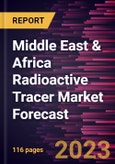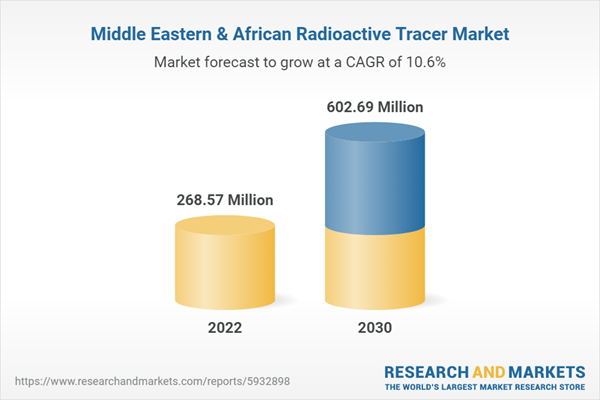The Middle East & Africa radioactive tracer market was valued at US$ 268.57 million in 2022 and is expected to reach US$ 602.69 million by 2030; it is estimated to grow at a CAGR of 10.6% from 2022 to 2030.
Based on test type, the Middle East & Africa radioactive tracer market is segmented into PET, SPECT, and others. The SPECT segment held the largest market share in 2022.
Based on end user, the Middle East & Africa radioactive tracer market is segmented into hospitals & clinics, diagnostic centers, academic & research institutes, and others. The hospitals & clinics segment held the largest market share in 2022.
Based on application, the Middle East & Africa radioactive tracer market is segmented into oncology, pulmonary, neurology, cardiology, and others. The oncology segment held the largest market share in 2022.
Based on country, the Middle East & Africa radioactive tracer market is segmented into Saudi Arabia, South Africa, the UAE, and the Rest of Middle East & Africa. Saudi Arabia dominated the Middle East & Africa radioactive tracer market share in 2022.
Rotem Industries Ltd, Invicro LLC, Cardinal Health Inc, Newcastle University, Novartis AG, Curium, and IBA Radiopharma Solutions are some of the leading players operating in the Middle East & Africa radioactive tracer market.
Increasing Use of Nuclear Imaging Techniques fuel the Middle East & Africa Radioactive Tracer Market
PET and SPECT are among the nuclear medicine radiology modalities employed in clinical settings. Their use is increasing as they offer accurate detection, localization, and characterization of diseases. Ionizing radiation for diagnosis and treatment benefits millions of patients globally. Radiation in medicine helps earlier diagnosis and often offers less invasive treatments for human diseases. Advanced radiation technology has opened new horizons in diagnostic and nuclear medicine, radiotherapy, and interventional radiology. According to World Health Organization, over 3,600 million diagnostic radiology examinations are performed, 37 million nuclear medicine procedures are carried out, and 7.5 million radiotherapy treatments are given annually. The development and introduction of new radiopharmaceuticals for PET/CT and SPECT/CT procedures, which are used in novel clinical applications such as neurology and orthopedics, and the growing accuracy of different tumor staging methods contribute to the growth of the radioactive tracer market. For instance, newly introduced cardiac radiopharmaceuticals such as flurpiridaz F-18 and ammonia N-13 help in more precise imaging of cardiovascular conditions. Thus, constant technological advancements for improving the quality and efficacy of nuclear imaging techniques favor the growth of the radioactive tracer market.Middle East & Africa Radioactive Tracer Market Overview
The Middle East & Africa radioactive tracer market is segmented into UAE, South Africa, Saudi Arabia and the Rest of Middle East & Africa. The regional growth is attributed to technological advancements and developments by market players offering radioactive tracer. Factors such as the rising healthcare infrastructure and the increasing number of chronic diseases, advancements in medical imaging and rising healthcare infrastructure are likely to further propel the market growth during the forecast period.Middle East & Africa Radioactive Tracer Market Revenue and Forecast to 2030 (US$ Million)
Middle East & Africa Radioactive Tracer Market Segmentation
The Middle East & Africa radioactive tracer market is segmented based on tracer type, test type, end user, application, and country. Based on tracer type, the Middle East & Africa radioactive tracer market is segmented into technetium-99m & Tc-97m, iodine-131, iron-59, lutetium-171, rubidium (Rb-82) chloride & ammonia (N-13), scandium-46, seaborgium-269, hassium-269, Gallium citrate Ga 67, Prostate-Specific Membrane Antigen (PSMA) (Ga-68), FDDNP (F-18) & FDOPA (F-18), phosphorus-32 & chromium-51, thallium-201, F-18 FDG, F-18 FAPI, Ga-68 FAPI, F-18 PSMA, DOTATOC/DOTANOC/DOTATATE (Ga-68), and others. The others segment held the largest market share in 2022.Based on test type, the Middle East & Africa radioactive tracer market is segmented into PET, SPECT, and others. The SPECT segment held the largest market share in 2022.
Based on end user, the Middle East & Africa radioactive tracer market is segmented into hospitals & clinics, diagnostic centers, academic & research institutes, and others. The hospitals & clinics segment held the largest market share in 2022.
Based on application, the Middle East & Africa radioactive tracer market is segmented into oncology, pulmonary, neurology, cardiology, and others. The oncology segment held the largest market share in 2022.
Based on country, the Middle East & Africa radioactive tracer market is segmented into Saudi Arabia, South Africa, the UAE, and the Rest of Middle East & Africa. Saudi Arabia dominated the Middle East & Africa radioactive tracer market share in 2022.
Rotem Industries Ltd, Invicro LLC, Cardinal Health Inc, Newcastle University, Novartis AG, Curium, and IBA Radiopharma Solutions are some of the leading players operating in the Middle East & Africa radioactive tracer market.
Table of Contents
1. Introduction
2. Executive Summary
3. Research Methodology
4. Middle East & Africa Radioactive Tracer Market - Key Industry Dynamics
5. Radioactive Tracer Market - Middle East & Africa Market Analysis
6. Middle East & Africa Radioactive Tracer Market - Revenue and Forecast to 2030 - by Tracer Types
7. Middle East & Africa Radioactive Tracer Market - Revenue and Forecast to 2030 - by Test Type
8. Middle East & Africa Radioactive Tracer Market - Revenue and Forecast to 2030 - by Application.
9. Middle East & Africa Radioactive Tracer Market - Revenue and Forecast to 2030 - by End User
10. Middle East & Africa Radioactive Tracer Market - Country Analysis
11. Radioactive Tracer Market Industry Landscape
12. Radioactive Tracer Market, Key Company Profiles
13. Appendix
List of Tables
List of Figures
Executive Summary
At 10.6% CAGR, the Middle East & Africa Radioactive Tracer Market is Speculated to be worth US$ 602.69 million by 2030.According to this research,, the Middle East & Africa radioactive tracer market was valued at US$ 268.57 million in 2022 and is expected to reach US$ 602.69 million by 2030, registering a CAGR of 10.6% from 2022 to 2030. Rising prevalence of chronic diseases and increasing use of nuclear imaging techniques are the critical factors attributed to the Middle East & Africa radioactive tracer market expansion.
One of the primary opportunities within the radioactive trace market in Europe lies in the healthcare and diagnostics sector. The emerging economies of region such as Hungary, Poland, and Romania, are experiencing high growth and development in their healthcare infrastructure. The region’s vast and rapidly growing population, coupled with and increasing focus on healthcare infrastructure development, makes it a fertile ground for the application of radioactive tracers. According to CABI estimates, cancer is currently one of the leading causes of mortality in the Middle East and North Africa (MENA). Still, the burden of new cases in the region is expected to nearly quadruple by 2030. Additionally, cardiovascular disease is the foremost cause of mortality in the MENA region, accounting for more than one-third of all fatalities, or 1.4 million people per year, according to the World Heart Federation. Furthermore, a notable increase trend in the point prevalence of Parkinson's condition has been documented in MENA during the previous three decades, indicating that the condition will continue to be a growing challenge for public health. Radioactive tracers play a significant role in diagnostic imaging techniques such as Positron Emission Tomography (PET) and single Phonton Emission Computed Tomography (SPECT).
As African countries advance their healthcare systems, there is rising demand for precise and early disease detection. Radioactive tracers, which allow for the visualization of molecular and cellular processes within the body, are instrumental in detecting various medical conditions, including cancer, cardiovascular diseases, and neurological disorders. They offer the advantage of early diagnosis and staging, leading to more effective treatment and improved patient outcomes.
Moreover, the increasing awareness among both healthcare professionals and the general public about the benefits of nuclear medicine and molecular imaging is driving the demand for radioactive tracers. This trend is further supported by a growing middle-class population with greater access to healthcare services. Thus, the radioactive tracer market in “region’s name” is poised to experience substantial growth as it becomes an integral component of advanced medical diagnostics and patient care.
On the contrary, short shelf-life of radioactive tracer hurdles the growth of Middle East & Africa radioactive tracer market.
Based on tracer type, the Middle East & Africa radioactive tracer market is categorized into technetium-99m & Tc-97m, iodine-131, iron-59, lutetium-171, rubidium (Rb-82) chloride & ammonia (N-13), scandium-46, seaborgium-269, hassium-269, Gallium citrate Ga 67, Prostate-Specific Membrane Antigen (PSMA) (Ga-68), FDDNP (F-18) & FDOPA (F-18), phosphorus-32 & chromium-51, thallium-201, F-18 FDG, F-18 FAPI, Ga-68 FAPI, F-18 PSMA, DOTATOC/DOTANOC/DOTATATE (Ga-68), and others. The others segment held 61.1% market share in 2022, amassing US$ 164.19 million. It is projected to garner US$ 347.46 million by 2030 to expand at 9.8% CAGR during 2022-2030.
Based on test type, the Middle East & Africa radioactive tracer market is categorized into PET, SPECT, and others. The SPECT segment held 44.4% share of Middle East & Africa radioactive tracer market in 2022, amassing US$ 119.36 million. It is projected to garner US$ 264.47 million by 2030 to expand at 10.5% CAGR during 2022-2030.
Based on end user, the Middle East & Africa radioactive tracer market is categorized into hospitals & clinics, diagnostic centers, academic & research institutes, and others. The hospitals & clinics segment held 70.2% share of Middle East & Africa radioactive tracer market in 2022, amassing US$ 188.56 million. It is projected to garner US$ 423.63 million by 2030 to expand at 10.6% CAGR during 2022-2030.
Based on application, the Middle East & Africa radioactive tracer market is categorized into oncology, pulmonary, neurology, cardiology, and others. The oncology segment held 60.6% share of Middle East & Africa radioactive tracer market in 2022, amassing US$ 162.75 million. It is projected to garner US$ 355.08 million by 2030 to expand at 10.2% CAGR during 2022-2030.
Based on country, the Middle East & Africa radioactive tracer market has been categorized into Saudi Arabia, South Africa, the UAE, and the Rest of Middle East & Africa. Our regional analysis states that Saudi Arabia captured 34.0% share of Middle East & Africa radioactive tracer market in 2022. It was assessed at US$ 91.18 million in 2022 and is likely to hit US$ 199.79 million by 2030, exhibiting a CAGR of 10.3% during 2022-2030.
Key players operating in the Middle East & Africa radioactive tracer market are Rotem Industries Ltd, Invicro LLC, Cardinal Health Inc, Newcastle University, Novartis AG, Curium, General Electric Co, and IBA Radiopharma Solutions, among others.
Companies Mentioned
- Rotem Industries Ltd
- Invicro LLC
- Cardinal Health Inc
- Newcastle University
- Novartis AG
- Curium
- General Electric Co
- IBA Radiopharma Solutions
Table Information
| Report Attribute | Details |
|---|---|
| No. of Pages | 116 |
| Published | December 2023 |
| Forecast Period | 2022 - 2030 |
| Estimated Market Value in 2022 | 268.57 Million |
| Forecasted Market Value by 2030 | 602.69 Million |
| Compound Annual Growth Rate | 10.6% |
| Regions Covered | Africa, Middle East |
| No. of Companies Mentioned | 8 |









